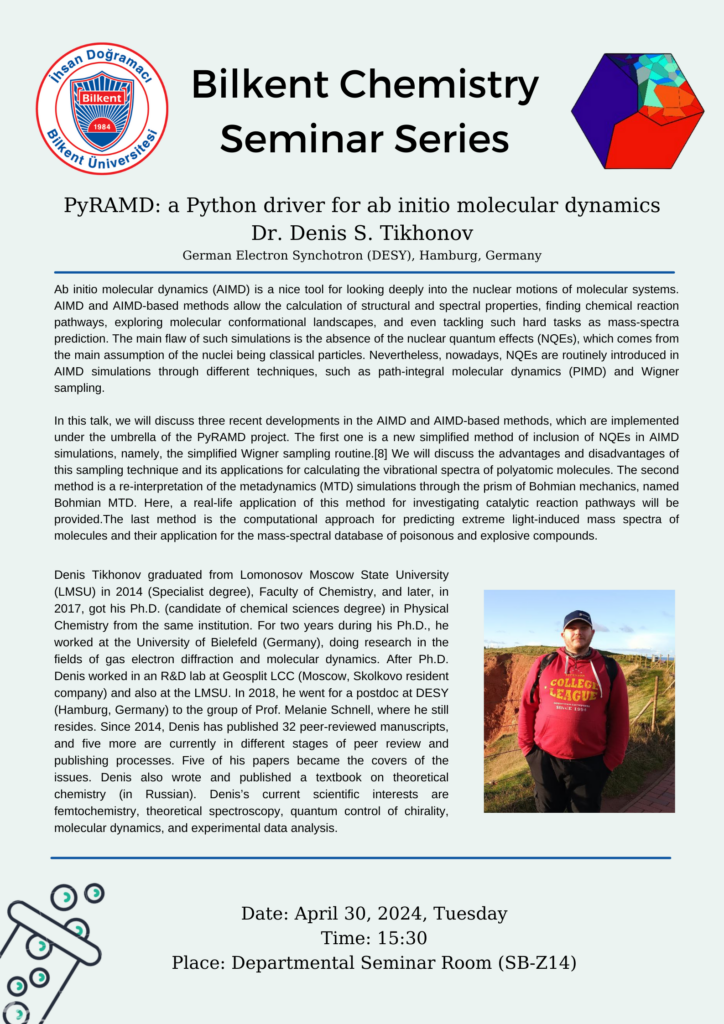Spring ’24 Department Seminars with Dr. Denis S. Tikhonov
Speaker: Dr. Denis S. Tikhonov
German Electron Synchotron (DESY)
Hamburg, Germany
Date: April 30, Tuesday
Time: 15:30
Place: Departmental Seminar Room (SB-Z14)

Abstract:
Ab initio molecular dynamics (AIMD) is a nice tool for looking deeply into the nuclear motions of molecular systems.[1] AIMD and AIMD-based methods allow the calculation of structural and spectral properties,[2] finding chemical reaction pathways,[3] exploring molecular conformational landscapes,[4] and even tackling such hard tasks as mass-spectra prediction.[5,6] The main flaw of such simulations is the absence of the nuclear quantum effects (NQEs), which comes from the main assumption of the nuclei being classical particles.[2,7,8] Nevertheless, nowadays, NQEs are routinely introduced in AIMD simulations through different techniques, such as path-integral molecular dynamics (PIMD) and Wigner sampling [8].
In this talk, we will discuss three recent developments in the AIMD and AIMD-based methods, which are implemented under the umbrella of the PyRAMD project.[9] The first one is a new simplified method of inclusion of NQEs in AIMD simulations, namely, the simplified Wigner sampling routine.[8] We will discuss the advantages and disadvantages of this sampling technique and its applications for calculating the vibrational spectra of polyatomic molecules. The second method is a re-interpretation of the metadynamics (MTD) simulations through the prism of Bohmian mechanics, named Bohmian MTD.[10] Here, a real-life application of this method for investigating catalytic reaction pathways will be provided.[11]
The last method is the computational approach for predicting extreme light-induced mass spectra of molecules and their application for the mass-spectral database of poisonous and explosive compounds.[11,12]
References:
[1] R. Iftimie et al. (2005). PNAS, 102(19), 6654-6659.
[2] D. Tikhonov et al. (2016). Phys. Chem. Chem. Phys., 18, 28325-28338.
[3] J. Hénin et al. (2022). Living J. Comput. Mol. Sci., 4(1), 1583.
[4] P. Pracht et al. (2020). Phys. Chem. Chem. Phys., 22, 7169-7192.
[5] H. Zettergren et al. (2021). Eur. Phys. J. D, 75, 152.
[6] S. Grimme (2013). Angew. Chem. Int. Ed., 52, 6306-631.
[7] T. Markland et al. (2018). Nat. Rev. Chem., 2, 0109.
[8] D Tikhonov et al. (2016). Phys. Chem. Chem. Phys., 18, 28325-28338.
[9] D. Tikhonov (2023). https://stash.desy.de/projects/PYRAMD/.
[10] D.S. Tikhonov (2023). J. Comput. Chem., 44, 1771.
[11] O.B. Beletsan et al. (2024). Phys. Chem. Chem. Phys., DOI: https://doi.org/10.1039/D3CP04654K.
[12] D. Tikhonov et al. (2020). Z. Phys. Chem., 234, 1507-1531.
[13] J. Lee et al. (2022). Phys. Chem. Chem. Phys., 24, 23096-23105.
Short Biography of the Speaker:
Dr. Denis Tikhonov graduated from Lomonosov Moscow State University (LMSU) in 2014 (Specialist degree), Faculty of Chemistry, and later, in 2017, got his Ph.D. (candidate of chemical sciences degree) in Physical Chemistry from the same institution. For two years during his Ph.D., he worked at the University of Bielefeld (Germany), doing research in the fields of gas electron diffraction and molecular dynamics. After Ph.D. Denis worked in an R&D lab at Geosplit LCC (Moscow, Skolkovo resident company) and also at the LMSU. In 2018, he went for a postdoc at DESY (Hamburg, Germany) to the group of Prof. Melanie Schnell, where he still resides. Denis’s current scientific interests are femtochemistry, theoretical spectroscopy, quantum control of chirality, molecular dynamics, and experimental data analysis.